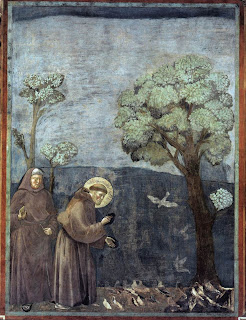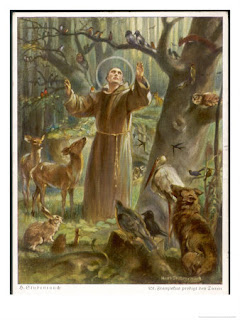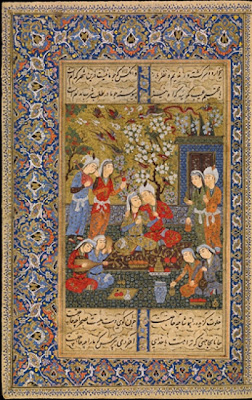By: Joanna, Janice, Rebecca, Ella and John
Jo's thoughts,
Q.4 - From Celano's stories, how do you understand Francis' relationship with the natural world?
- Celano puts a lot of emphasis on Francis' relationship with animals and nature. He states that it was these
relationships that Francis created which led to Pope John Paul II naming Francis the patron saint of Ecologists in 1983. So, Francis' work with nature and animals in the Middle Ages still relates to modern times because every April 22nd some choose to celebrate 'Earth Day' where people celebrate God's creation of all living things and caring for creation, just like Francis did.
- Celano uses stories that are highly descriptive and praising about Francis. Celano references the 'brother birds' of Spoleto, the 'Sister Swallows' from Alviano, and the 'Brother hare' from Greccio. Celano showcases Francis' great sympathy and patience with the natural world. None of Celano's stories show Francis dismissing any animals, he is always inclusive. As Francis was obedient to God, in return, God gave him the gift of having creatures obey him.
 |
| St Francis preaching to the birds by Giotto |
This is why Francis is radical - he recognised the importance of the natural world and therefore included natural life into his teachings. (According to Celano, it was as simple as calling birds "brothers and sisters") when others did not. (i.e. Merchants in new towns creating new roads, city life, not caring about the environment they were trampling over).
 |
| St Francis |
What I find interesting (as a side note), is that Francis' relationship with the natural world led to the birth of Italian Art. Again, as we know from the lectures art in the Middle Ages was very gothic - showing Christ in pain, helpless - a complete contrast to Roman Art.
However St. Francis is almost always depicted with a happy expression, with birds flying around him as he sings songs. He is always located in forests or in meadows to symbolise his relationship with the natural world. Even a little later with the Baroque artists, while Christ is still depicted as pale and skinny, Francis appears healthier with 'dreamlike' expressions on his faces.
 |
| St Francis preaching to the animals |
Rebecca's thoughts,
3. In Celano’s account of Francis’ life, with what values does he imbue the figure of Francis? Discuss with examples from the text.
· Embarks on a gradual conversion at the age of 23, after a ‘spirit led him to enter the church and pray’, leading him to reject his former life and his father’s wealth.
· Surrenders himself completely to God’s will, he is compassionate and loyal, preparing to ‘follow the blessed impulse of his soul, progressing to higher things and trampling worldly interests underfoot.’
· Described as a ‘new solider of Christ’, he completely moves away from ‘living riotously among his relations and acquaintances’ to being one who is ‘contemptuous of money, treating it as if it were dust’. His only wish is to possess wisdom.
· He ‘burns with a devotion toward the mother of all good’, living with lepers and rebuilding the church and is completely concerned with preaching the kingdom of God, penance and the gospels which he ‘diligently’ attempted to ‘fulfill to the letter’.
· Deeply humble, and ‘impelled by a higher desire’, devoutly wished for something else, not satisfied to just to live the life of a hermit or monk, as felt God held a different task for him.
· Francis is depicted as ‘that most blessed servant of God, a man of great fervor’ and sympathy toward the lower, irrational creatures’ (animals) which he loved with ‘maternal affection’. Through this ‘striking rapport with animals’, the Pope proclaimed Francis the patron saint of the ecological movement.
· Very concerned with purging himself of temptations from the devil, dressing in a rough tunic in order to crucify the vices and sins of the flesh.
· Francis and his followers practiced mortification of the flesh- not because they considered the body to be evil, it too is a creation of God, but in a ‘fallen world’ it could distract one from higher pursuits.
· Held a great emphasis on humility and a desire to imitate Christ with completely obedience.
· Described as ‘scattering the seeds of his blessing everywhere’, with people filled with so much love, belief and devotion for him that they trampled one another to see and hear him.
· In the presence of Francis, ‘heretical depravity was confounded, the faith of the Church was extolled’, and while the ‘faithful engaged in jubilation, heretics went into hiding’. For so many ‘signs of sanctity appeared in him’ that no one dared to oppose his words.
· However, although he received great attention, he felt great affection for priests and every ecclesiastical order. Performs several miracles, curing of various diseases and turning water into wine.
· His highest intention, greatest desire and supreme purpose was to observe the holy gospel in and through all things. He wanted to follow the doctrine and walk in the footsteps of Jesus, and to do so ‘perfectly, with all vigilance, all zeal complete desire of the mind complete fervor of the heart’ until his death.
· One needs to keep in mind that this work was of course commissioned by a pope, Gregory IX, and written in the period after his death and canonization by an early member of the Franciscan order and later additions of other brothers.
Janice's thoughts,
THE DOMINICANS
The
Dominican Order, also called the Order of Preachers, was initially
founded by a Spanish priest, Dominic de Guzman, to try and control the Cathar
heresy. They were itinerant preachers of the Gospel, walking everywhere to try
and engage the Cathar leaders in debate. In 1215 Dominic went to Rome to ask
the Pope for permission to set up a new order, but the Fourth Lateran Council,
in session at the time, refused as they thought there were too many religious
groups running around and should adopt an existing rule, so Dominic chose the Rule of Augustine (created in the fifth
century by St Augustine of Hippo) since he was already affiliated with that
Order. The Augustinian monks adhered to a pattern of discipline and spiritual
life, served in churches and cathedrals and were involved in the social needs
of their local town.
Dominic was university educated and from
the beginning the Dominicans focussed
more on learning and education. Ultimately his best recruits came from the
finest intellectual institutions in Europe. Manual labour was discarded to
allow for more study and preaching, meanwhile living a life of poverty. Dominic
was very devout and said to be always preaching or talking or arguing about
God. He was very skilled in administration and organisation and was responsible
for the first set of statutes governing internal matters in 1228 which became
their new constitution modelled on monastic traditions and daily choral
recitations.
Like Francis he also attracted women and
the sisters were known as the Poor Clares
who became an associate order of the Dominicans.
Things to think about –
- What were the differences between the Franciscans and the Dominicans and why?
- Why were the Dominicans so popular with the masses?
Good luck with the readings everyone.
 |
| St Dominic |





